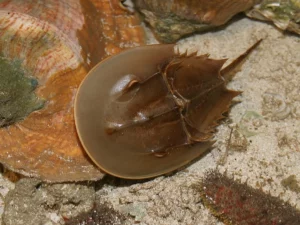As the name suggests, Horseshoe crabs are horse-shoe shaped and multicellular. These are the members of phylum Arthropoda. Let us discuss some examples of horseshoe crabs.
- Limulus polyphemus
- Tachypleus tridentatus
- Tachypleus gigas
- Carcinoscorpius rotundicauda
Limulus polyphemus
Limulus polyphemus are mostly found near estuarine bodies. They are up to 2 feet long. They are distributed all over Mexico and also on the Atlantic Coast of North America. That is why they are also known as Atlantic/American Horseshoe crab or commonly called “King crab”.

Listed below are some of the characteristic features of Limulus polyphemus:
- Limulus polyphemus show gonochorism(dioecious).
- They are oviparous and show external fertilization.
- They have separate digestive, respiratory, excretory and reproductive organs.
- They show an adaptation of having numerous eyes: 7 simple eyes and one pair of compound eyes, composed of a single unit of ommatids.
- Coxal glands act as an excretory organ as they use to eliminate waste material of the body into the outer environment. They are predominantly ammoniotelic but sometimes behave as ureotelic.
- They are a living member of the group and are listed as Vulnerable species by IUCN.
- They also show 1O immune response as in procaryotes as they have front-line defensive cells termed “amoebocytes” and are exploited by anthropogenic activities.
Tachypleus tridentatus
T. tridentatus have blurry, mosaic and monochromatic vision due to the presence of ocelli, which acts as the lenses. and are mostly restricted to Florida, Asia including India and Japan that is why, it is also known as Japanese horseshoe crabs. They eat sea larvae and are eaten by sea turtles.

Listed below are some of the characteristic features of Tachypleus tridentatus:
- The moulted shells of Tachypleus tridentatus are found near the seashore by the flow of water.
- Males are heavier than females and have gonads for syngenesis or mating.
- Females can lay approx. 75000 eggs throughout the season.
- Their compound eyes have photoreceptors which respond to ultraviolet rays.
- Digestion takes place with the help of a gizzard and some digestive enzymes in the gut for grinding larger food molecules into smaller ones.
- Respiration takes place with the help of gills and sometimes by the general body surface.
- The body is again divided into 3 sections:
- Prosoma is the first and the front shell and is horse-shoe shaped. It constitutes of compound eye and an incomplete nervous system.
- While the second one is opisthosoma which is a hard covering on the back side of the organism.
- Third and the last one is the tail or telson with a sharp, shiny and spiny appearance used for flipping and is non-detrimental. These tails can be mostly used in navigation during the night as they contain a series of light-sensing receptors for navigation.
Tachypleus gigas
Tachypleus gigas are mostly found on the eastern coasts of Asia which is why they are known as coastal horseshoe crabs. They are native to West Bengal, India. They have prosoma, abdomen and telson and have a pair of reduced appendages called Chilaria, which lie under the subphyla- Chelicerata.
Listed below are some of the characteristic features of Tachypleus gigas:
- Tachypleus gigas do not have venom, are not detrimental and can spawn during the full moon of May and June.
- The body cavity is filled with haemocoel having hemocyanin as the respiratory pigment which possesses amoebocytes.
- These cluster of cells acts as the immune system which prevents the organism from pathogenic attack and other predators.
- They do have a semi-closed circulatory system. The colour of hemocyanin is blue to the presence of copper ions.
- Dorsally, ganglia fuses and forms a nerve ring and a double ventral nerve chord comprise a nervous system.
- The chitinous cuticle does not allow body expansion that is why they have to perform moulting or ecdysis.
- Their eggs are the major food source of shorebirds.
Carcinoscorpius rotundicauda
C. rotundicauda are native to the South China Sea and are commonly known as Southeast Asian crabs. They are found in estuarine ecosystems and confined to Sundarbans coastal. It is usually found in mangrove swamps which is why known as Mangrove Horseshoe crab and is involved in the Benthic food chain.
Listed below are some of the characteristic features of Carcinoscorpius rotundicauda:
- Carcinoscorpius rotundicauda feed on red algae, sea-floor organisms like oligochaetes, polychaetes, marine maggots and also on dead organic matter.
- Prosoma is large, hinged attached with hard piece carapace followed by opisthosoma and tail is for flipping.
- They are monogamous and have chemoreceptors for mating.
- They are quite injurious as they contain a chemical substance “tetrodotoxin”, lethal to biological systems.
- They possess two bioactive compounds in blood i.e., Limulus Amoebocyte Lysate (LAL) and Tachypleus Amoebocyte Lysate (TAL) which is widely used by humans to cure immune-related ailments.
- They are categorised under the IUCN Red List of Threatened species.
- Tachypleus Amoebocyte Lysate can also be used in laboratories for the detection of gram-negative bacteria. But over exploitation may lead to extinction.
Conclusion
We can conclude that horseshoe crabs are the most intriguing ocean-dwellers. These four species of arthropods are known as “living fossils”. These are very helpful in the biomedical industry as amoebocytes play a vital role in regrowth and regeneration and can be extracted for the therapeutics of genetic disorder in humans.
Also Read:
- Is secondary transport active
- Bamboo tree
- Light reaction of photosynthesis
- Adenine structure in rna
- Examples of endoparasites
- Nucleotide structure insight and significance
- Function of cytoplasm in bacteria
- Butterflies examples
- Antiparallel dna strands 2
- Closed ecosystem

Hi….I am Anushree Verma, I have completed my Master’s in Biotechnology. I am a very confident, dedicated and enthusiastic author from the biotechnology field. I have a good understanding of life sciences and great command over communication skills. I thrive to learn new things every day. I would like to thank this esteemed organization for giving me such a great opportunity.
Let’s connect through LinkedIn- https://www.linkedin.com/in/anushree-verma-066ba7153